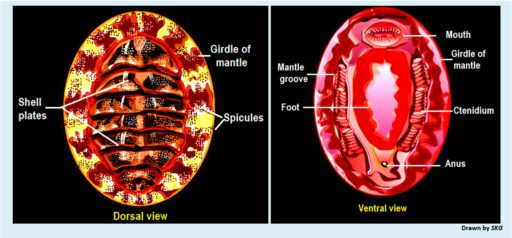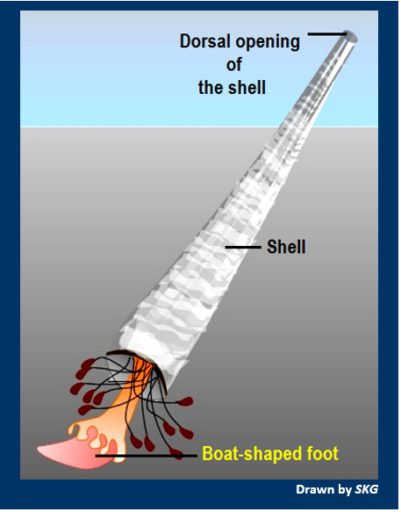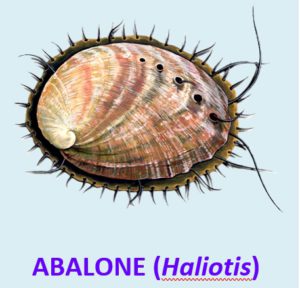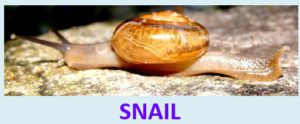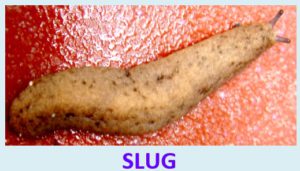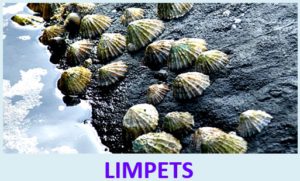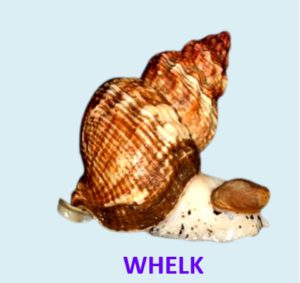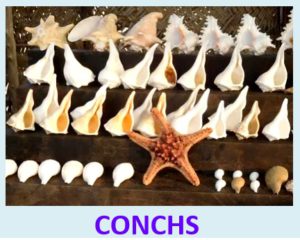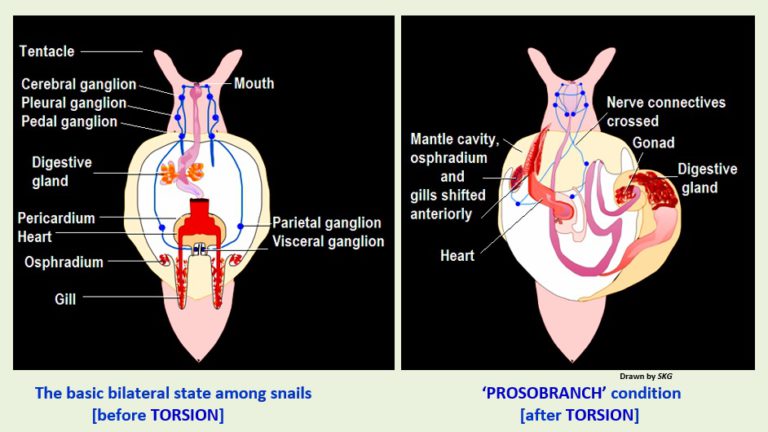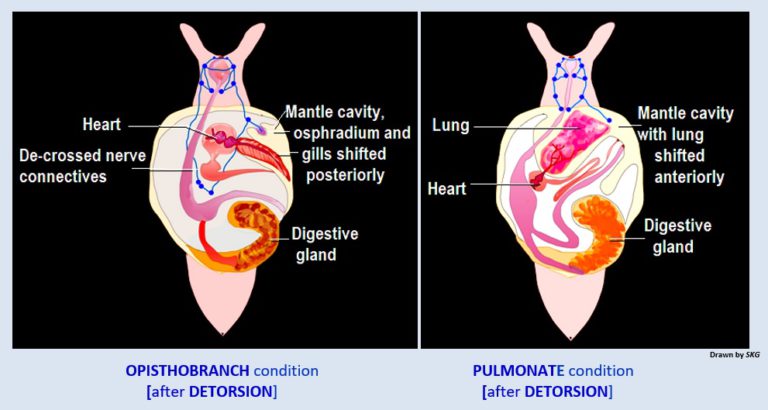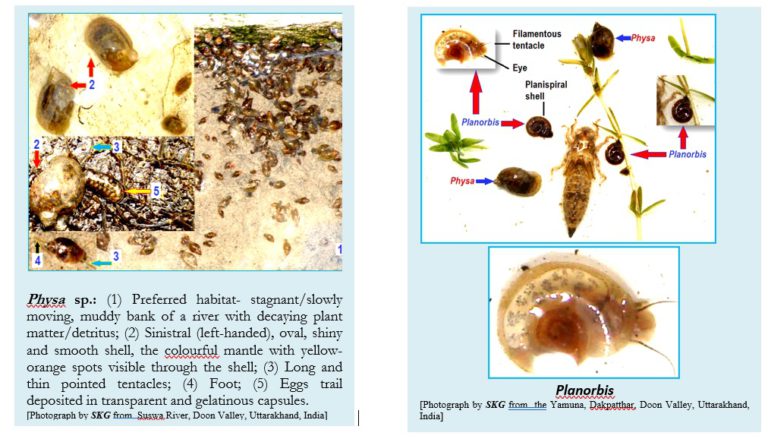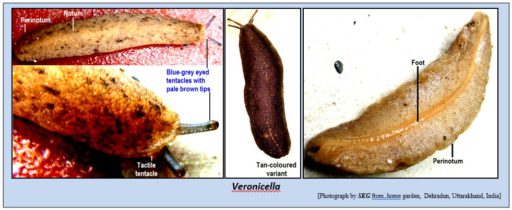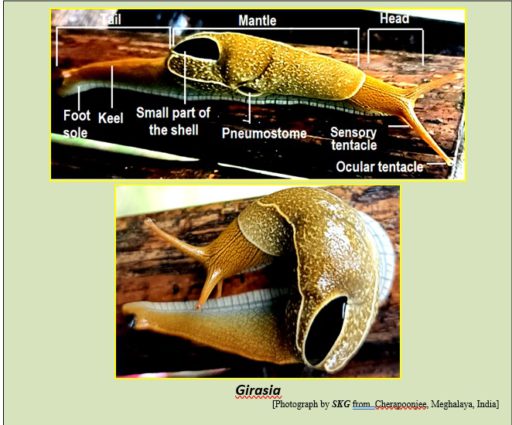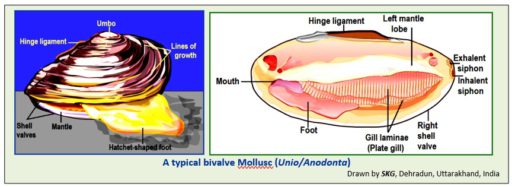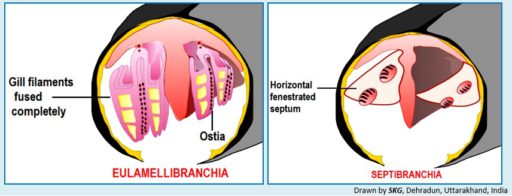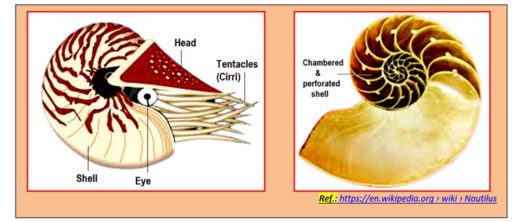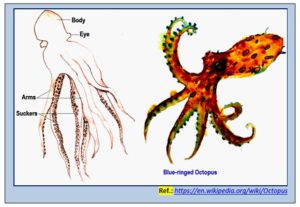A Recapitulation:
Making Biology students interested in Etymologies’ !!!
v
FUN TO LEARN BIOLOGICAL TERMINOLOGY
v
THE LANGUAGE OF BIOLOGISTS
v
SOWING SEEDS OF SYSTEMATICS/TAXONOMY AT THE GRASSROOT LEVEL
LEARNING BIO- ETYMOLOGY
Over a period in past centuries, Science is general and Biology in particular has accumulated a vast array of words to communicate fact(s) or phenomena through deriving their meanings.
The episode(s) of ‘Bio-etymology’ are, thus, devoted to analyzing the hidden meanings derived from the Names of various Animal Phyla and Classes, along with the terms specifically used to describe their respective diagnostics, important examples (Genus or species) etc.
Ø Recollecting the Introduction of PART – 1:
At any level, may it be animals in general or Man in particular, there is some structured or indicative or behavioural system of communication. It is simply referred to as a kind of ‘Language’. In a broader sense, ‘Language’ is the method of communication that involves the use of various languages (in various countries) spoken by man. Articulation of words in a definite sequence is the basic of formulating a Language and knowledge of words forming it and their ‘sense’ is of utmost importance. Accumulation of a treasure of words constitutes what is called ‘Vocabulary’ defined variously as follows
1. The words of a language.
2. The body of words used in a particular language.
3. All the words that exist in a particular language or subject.
4. A list or collection of the words or phrases of a language, technical field etc.
5. A listing either selective or exhaustive, containing the words and phrases of a language, with meaning or translations into another language.
Ø The Previous Episodes of Bio-etymology:
BIO-ETYMOLOGY: PART – 11
PHYLUM –MOLLUSCA
[French mollusque < L. molluscus < mollis < Gk. malakos = soft]
The name of the Phylum literally means ‘soft-bodied’ animals (mostly protected by self secreted hard external/internal shell), including a vast array of animals commonly known as – tusk shells, clams, mussels, cockles, scallops, oysters, abalones, snails, limpets, whelks, olive shells, cone shells, cuttlefish, squids, octopuses etc. The branch of study of Molluscs is called ‘Malacology’ [L. molluscus < mollis / Gk. malakos = soft + Gk. logy/logos = the study of certain subject].
With these diverse common names of animals included, Phylum ‘Mollusca’ constitutes the ‘second largest Phylum’, with nearly 100,000 (possibly as many as 150,000) described species, about 23% being exclusively marine. They are highly diverse, not only morphologically and anatomically, but also behaviouraly and habitat-wise. A good number of them are also freshwater and terrestrial. A few examples are found parasitic also.[Ref: https://en.wikipedia.org › wiki › Mollusca]
HISTORY
Greek philosopher Aristotle (384 – 322 BC) was
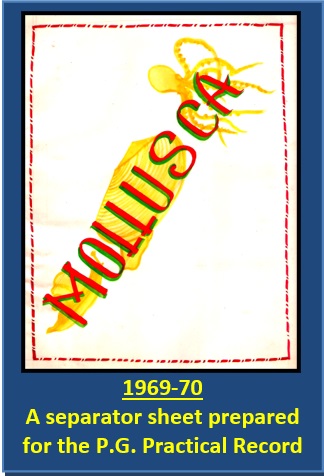 the first to study Molluscs and in his ‘Historia animalium’ the first universal classification of animals was presented through distinction between ‘blooded’ (vertebrates) and ‘bloodless’ (invertebrates) animals. The group of bloodless animals included at least four types of animals viz., insects, crustaceans, testaceans and molluscs, of which ‘testaceans’ (Ostracoderma) and ‘molluscs’ (Malakia) are the two divisions of that large group known today as the Phylum Mollusca. Aristotle’s Malakia included mostly cephalopods, whereas Ostracoderma included gastropods and bivalves, as well as some other shelled organisms.
the first to study Molluscs and in his ‘Historia animalium’ the first universal classification of animals was presented through distinction between ‘blooded’ (vertebrates) and ‘bloodless’ (invertebrates) animals. The group of bloodless animals included at least four types of animals viz., insects, crustaceans, testaceans and molluscs, of which ‘testaceans’ (Ostracoderma) and ‘molluscs’ (Malakia) are the two divisions of that large group known today as the Phylum Mollusca. Aristotle’s Malakia included mostly cephalopods, whereas Ostracoderma included gastropods and bivalves, as well as some other shelled organisms.
Polish naturalist Joannes Jonston (1650) coined the name Mollusca, as a substitute for ‘Mollia’ for the cephalopods and barnacles, introduced by Pliny, the Elder or Gaius Plinius Secundus (AD 23/24 – 79) in his work the Natural History (L. Naturalis Historia). But, this name was not accepted until redefined by Linnaeus.
Linnaeus (1758) included different molluscan taxa (in modern sense) under three orders of the Classis ‘Vermes’ viz.,
Order Intestina: Genus Teredo along with such dissimilar creatures as Lumbricus (earthworm), Hirudo (leech), Ascaris (helminthes), and Myxine (hagfish).
Order Mollusca (similar to Aristotle’s Malakia): The molluscan genera (Limax, Doris, Sepia and others) were included here, accompanied by such genera of soft-bodied aquatic animals from other invertebrate Phyla, such as Medusa, Asterias (starfish), Nereis and Holothuria.
Order Testacea: a species rich taxon including clams, snails, chitons as well as crustaceans (Lepas), annelids (Serpula) and scaphopods (Dentalium).
British naturalist Emanuel Mendes da Costa (1770) coined the word ‘Conchology’ (Gk. konkhos /L. concha = shell, cockle + Gk. logy/logos = the study of certain subject) for the branch of study of (molluscan) ‘shells’ and published ‘The Elements of Conchology’: or an Introduction to the Knowledge of Shells (1776). His last publication was ‘British Conchology’ (1778).
French Zoologist Jean Léopold Nicolas Frédéric Cuvier or Georges Cuvier (1795) devised the modern ‘conception of molluscs’ and used the term ‘Mollusca’ to describe squids and cuttlefish. Cuvier called them ‘white-blooded animals’ and included both ‘shelled’ and ‘non-shelled’ groups in a single taxon viz., ‘class des mollusques’ (= ‘classis of mollucs’), divided into three orders viz., les céphalopodes, les gastéropodes and les acéphales, respectively corresponding to Cephalopoda, Gastropoda and Bivalvia. This development is regarded as the beginning of the true ‘revolution’ in the malacological systematics.
The Cuvier’s works are also considered as the starting point of transformation of classical ‘conchology’ (= study of shells) into modern ‘Malacology’ (= study of molluscous animals as whole organisms).
French-American naturalist Constantine Samuel Rafinesque-Schmaltz (1814) proposed the very term ‘Malacology’.
Ducrotay de Blainville (1825) proposed a new term, ‘malacozoaires’ (Malacozoa) for ‘Malacology’, to designate all such invertebrates with soft coverings. `
DEFINITION / DIAGNOSTICS
‘Bilaterally symmetrical, protostomial eucoelomate, unsegmented eumetazoans with a body enclosed in a fold of skin (Mantle), usually secreting a calcareous external/internal shell’.
· Free living (marine, brackish, freshwater, terrestrial or aerial) or parasitic. Herbivorous or carnivorous (predaceous). Creeping, burrowing, free-swimming or attached to rocks.
· Triploblastic: [Gk. triploos/triples; Latin triplus = threefold/three + blast(os) = denoting embryonic cell/ germ layer of an embryo/germ/sprout + -ic < Latin –icus / Gk. –ikos = the suffix used to form adjectives], i.e., the animal’s body developing from three primary germ layers viz., Ectoderm, Endoderm and Mesoderm.
· Bilaterally symmetrical: [Gk. bi = two + lateros = sides], i.e., body divisible into two identical halves (right and left) only in one plane passing through the median longitudinal axis. Secondarily coiled and asymmetrical due to TORSION.
· Body unsegmented, except Monoplacophora; soft and slimy, divisible into head, mantle, foot and visceral mass.
PSEUDOMETAMERISM vs TRUE METAMERISM Please refer to Bio-etymology PART – 5 HOMONOMOUS vs HETERONOMOUS METAMERISM |
§ Head: Prominent with tentacles and eyes or reduced/rudimentary.
§ Mantle: Dorsal fin-fold of skin, enveloping the body and secreting the ‘shell’.
§ Foot: Ventral, muscular organ variously adapted for creeping, swimming or burrowing [the names of various ‘Groups’ are identified, on the basis of the kind of FOOT].
§ Visceral Mass: The congregation of most of the systems like respiratory, digestive, circulatory (Heart), excretory, reproductive, nervous etc., at a limited available place.
· Exoskeleton:
Present or absent. When present, it is mostly in the form of an external ‘Calcareous shell’ (univalve or bivalve); internal in some (Class – Cephalopoda); secreted and lined by ‘mantle’ [L. mantellum = cloak = anything that covers or conceals something] or ‘pallium’[L. pallium = covering = a draped rectangular cloth worn as a cloak by men
of ancient Greece and Rome]. In some cases (Class – Aplacophora), the exoskeleton is
merely represented by a cuticular (horny) layer provided with calcareous/aragonite spicules.
·
Eucoelomate: [Gk. eu = true, well, good + koiloma / koilia = hollow, cavity]
In all the higher bilateria, from Annelids onwards, the blastocoel gets obliterated by the development of endodermal ‘archenteron’ [embryonic gut] and another space (true coelom or eucoelom) is created between two layers of mesodermal cells (peritoneum) present between the gut (endoderm) and the body wall (ectoderm).
Coelom is reduced in Molluscs, restricted to pericardial cavity and to small spaces within excretory and reproductive organs.
For the types of Coelom in ‘Bilateria’, |
· Digestive system: complete with a digestive gland (hepatopancreas) and a rasping organ ‘RADULA’ inside buccal cavity (secondarily absent in filter-feeding bivalves).
· Blood vascular system: open type; blood colourless or coloured blue or green due to ‘haemocyanin’ pigment and transported within sinuses. ‘Heart’ posteriodorsal, enclosed in pericardium, with a ventricle and two posterior auricles.
· Respiration: through paired gills or ctenidia [Gk. ktenidion = comb or comb-like gill] or lungs or both.
· Nervous system: with paired ganglia, connectives (nerves connecting two different ganglia) and/or commissures (nerves connecting two similar ganglia).
· Sensory organs: eyes, chemo- and tactile receptors, statocysts etc.
· Dioecious: [Gk. di = two + oiki(on) or oikos = house] or Monoecious [Gk. mono = one + oiki(on) or oikos = house]; sexes separate or some showing hermaphroditism; gonads one or two with gonoducts opening into renal ducts or outside.
· Fertilization: external or internal.
· Development: direct or indirect. When indirect, it is with various larval stages viz.,
Phylum MOLLUSCA is traditionally divided into 7 Classes, the Class 1 to 3 identified/named on the basis of the characteristics of ‘SHELL’, whereas the Class 4 to 7 highlight the characteristics of the ‘FOOT’. Besides, the characteristics of ‘RESPIRATORY ORGANS’ (Gills/Lungs) are taken as diagnostic to the Subclasses/Orders of Class 5 to 7.
v Class 1- 3: Named on the basis of ‘SHELL’ characteristics:
CLASS 1: APLACOPHORA (Glisten Worms or Sclerite-Bearing Deep-Sea Molluscs)
[Gk. a = no + plax = plate + pherein = bearing]
i.e., referring to those deep sea (up to about 6000 m), ‘vermiform’ (shaped due to the enrolling of mantle margins), small (5.0 – 30.0 cm) molluscans, without a typical molluscan shell. The ‘FOOT’ is in the form of a narrow ‘pedal groove’ or is completely reduced. The exoskeleton is merely represented by a cuticular (horny) layer provided with calcareous/aragonite spicules or sclerites, with striking sheen (hence, Glisten Worms).
CLASS 2: MONOPLACOPHORA
[Gk. mono = one + plax = plate + pherein = bearing]
i.e., referring to most recently discovered (1952) limpet-like [Middle English limpet/limpet; Old English lamprede/lempedu/lamprey = denoting adhesive properties; as both the ‘limpet’ and the ‘lamprey’ are recognized for their adhesive properties], small (about 3.0 cm), bilaterally symmetrical molluscans from the abyss of the sea (at about 5000 m), having a dome-shaped/cap-like shell. The foot is oval and flat, enabling them to slowly crawling or attaching to the rocks. Presence of five pairs of comb-gills (Ctenidia) and serial repetition of the organs like kidneys and heart etc. gives a clue about their segmented nature and possible origin from segmented animals.
Example(s):
· Neopilina: [Gk. neo = new + Pilina = name of an extinct species] i.e., referring to a ‘new Pilina’ (after Pilina, an extinct monoplacophoran species that lived about 400 million years ago) [< L. pilla/pilula = pills/tablet i.e., referring to the shape of ‘Monoplacophorans’, as a small, tablet-like object].
CLASS 3: POLYPLACOPHORA (Chitons/Coat of mail shells/Gumboots/Sea cradles)
[Gk. poly = many + plax = plate + pherein = bearing]
i.e., referring to those flattened, oval (8.0 mm – 33.0 cm), marine intertidal molluscans, living in rocky zones (up to 6000 m), having a ‘shell’ of 8 dorsal, overlapping plates or valves; bordered by a thick girdle of ‘mantle’, often covered with spines or scales. Foot flat and large, used for creeping along and clinging to rocks.
Example(s):
· Chaetopleura (Chiton):
THE ‘COMMON NAMES’
Ø Chitons: [Gk. khiton = tunic] i.e., a long ‘woolen tunic’ worn by ancient Greece; akin to long and flattened body of the ‘molluscan’ covered by overlapping plates. ‘Chiton’ was a simple tunic garment, secured along the shoulders and lower arms by a series of fastners (= the shell plates of the molluscans); shortened ‘chitons’ used to be worn during activities by athletes, warriors or slaves (for protection).
Ø Coat of mail shells: This name refers to ‘a jacket covered with or composed of metal rings or plates (= mails), serving as an armour for the ancient Greeks; reminding the ‘overlapping shell plates’ of these molluscans.
Ø Gumboots: Heavy rubbery ‘shoes’ covering part of legs; reminding the appearance of the ‘Chitons’, resembling to part of a rubbery Wellington boot or ‘gum rubber boot’.
Ø Sea cradles: The shape of ‘Chitons’ reminds about a framework (= cradle) on which a ship or boat
rests during construction or repairs.
Ref.: https://en.wikipedia.org › wiki › Chiton
Class
4- 7: Named on the basis of ‘FOOT’ characteristics
CLASS 4: SCAPHOPODA (Tusk Shells/Shovel-foot)
[Gk. skaphe = boat + pous/pod = foot]
i.e., referring to those marine, tubular-shelled molluscs, adapted to living at the bottom; lying buried in marine mud and sediments with the help of ‘boat-shaped or shovel-like foot’.
Example(s):
![]() Dentalium:[L. dentis = tooth] i.e., referring to the ‘tusk-shaped’ form of these mollusks
Dentalium:[L. dentis = tooth] i.e., referring to the ‘tusk-shaped’ form of these mollusks
THE COMMON NAMES
Ø Tusk Shells: referring to their conical shells (open at both ends), slightly curved dorsally, making the shells appearing like
tiny ‘tusks’ (= elephant tooth).
Ø Shovel-foot: referring to the ‘shovel-shaped foot’, used for burrowing in marine mud and sediments.
Ref.: https://ucmp.berkeley.edu/taxa/inverts/mollusca/scaphopoda.php
CLASS 5: GASTROPODA
[Gk. gaster = belly/stomach/paunch + pous/podos = foot]
i.e., referring to a vast array of Molluscs having a large/flat/sole-like foot positioned just below the gut/belly. Most Gastropods possess ‘Ctenidial Gills’ (Comb-like, bipectinate, having a shape similar to a bird’s feather, with filaments projecting on either side of a central stalk) but some have adapted to terrestrial and amphibious life by developing ‘lungs’ as specialisations of the mantle/pallial cavity (Subclass – Pulmonata).
GASTROPODA
THE SECOND LARGEST CLASS
Constituting about 80% of the Molluscans, Gastropoda is the second largest class (after the Insecta), with about 13,00 Genera and 40,000–90,000 living species. These univalved Molluscans (Abalones, Snails, Slugs, Limpets, Sea Slugs, Whelks, Conchs etc) have an extraordinary diversification of habits and habitats, ranging from gardens, woodland, deserts, mountains, small ditches, great rivers and lakes; estuaries; coastal areas to ocean depths. Since they utilize a variety of ecosystems, evolutionarily they are regarded as the most successful group. As per feeding habits, some scrape algae from rocks along the river/pond/ocean floor and some cling to large freshwater/marine plants and feed on them. Interestingly, parasitism and carnivorous/predatory/necrophagous [= feeding on corpses or carrion] life styles are common in marine gastropods. Asterophila (Prosobranchia, Eulimidae) from Antarctic Peninsula, is an exclusively endoparasitic gastropod, forming cysts in the arms and central discs of sea stars. Moreover, certain slugs and terrestrial snails participate in transmission of digenetic Trematode/Nematode larval stages, including those pathogenic to man. On the other hand, venomosity among gastropods is not an exception; belonging to about 20 Families of marine carnivorous Order (Clade) Neogastropoda.
[pl. refer to Fish and Fisheries Digest – PART 4 ‘Poisonous and Venomous Fishes and Shellfishes’; available online with AMAZON digital services LLC – Kdp Print Us: https://www.amazon.co.uk › ]
COMMON NAMES
· Abalones: [< English Abalone < Spanish abulón = edible univalve mollusc; = any of a Genus Haliotis < Gk. halios = marine + ous/otis = ear] i.e., referring to some edible rock-clinging gastropod molluscs having a flattened, slightly spiral, ear-shaped shell (hence, ear shells, sea ears), lined internally with mother-of-pearl (used for making jewelry or other ornaments) and with a row of respiratory apertures along its outer edge.
· Snails: [< Middle English < Old English snægl < German snecko = snail < German snahhan = to creep; a slow-moving or sluggish person or thing; to move, act, or go slowly or lazily] i.e., referring to a ‘slow-creeping’ gastropod mollusc having an external enclosing spiral shell.
or
Snail < L. cochlea < Gk. kokhlias = a snail with a spiral shell.
· Slugs: [< Middle English noun < slugge or sluggard = lazy person, / < Norwegian dialect noun sluggie = heavy or slow person] i.e., referring to any of the pulmonate, muscular/heavy-bodied, sluggish gastropod molluscs without or with a rudimentary shell.
· Limpets:[<Middle English limpet/limpet; Old English lamprede/lempedu/lamprey = denoting adhesive properties < L. lampetra: lambo = I lick, lap + petra = stone, rock] i.e., referring to small marine or freshwater molluscs (Patellidae) with a conical shell and found clinging to rocks in the intertidal zones of rocky shores. Not to be emphasized that both the ‘limpet’ and the ‘lamprey’ are recognized for their adhesive properties.
· Whelks (Scungilli): [< Old English weoloc/wioloc < German weluca < Dutch willoc = to turn, revolve, volute] [volute < French volute < Italian/Latin voluta/volvere = a spiral scroll, to turn around, roll] i.e., referring to any of the marine, large, spiral-shelled gastropods (Buccinidae)
Scungilli < Italian scunciglio = sea shell.
· Conchs: [< L. concha = shellfish, shell < Gk. konkhe = mussel, cockle or shell-like cavity < Sanskrit sankha = conch shell] i.e., referring tropical marine mollusks with a strong, spiral shell, bearing long, spinous projections and flared lip.
TORSION AND DETORSION IN GASTROPODA
[A basis for further Classification of Gastropods]
Ø TORSION: In contrast to Monoplacophorans, which have a ‘bilateral symmetry’, during evolutionary process and larval development, some members of Gastropoda underwent a unique process of ‘twisting’ (Torsion) of the body through 180°, thus disturbing the bilateral arrangement of visceral organs. Because of torsion, the pallial cavity with the gills and the osphradium (= chemical-mechanical sense organ), gets shifted anteriorly. Therefore, snail groups in this state of torsion are referred to as prosobranch snails (= front-gill snails). Further, the ‘neural connectives’ i.e., the nerves connecting the cerebral, pedal and pleural ganglia near the head and parietal and visceral ganglia in the body, also become ‘twisted’ or ‘making a cross’, a condition referred to as ‘Chiastoneury’ or ‘Streptoneury’ (= crossed-nerve state).
Ø DETORSION: Further, under the given set of conditions, a ‘reversal of Torsion’ was also witnessed in some Gastropods, as a process called ‘Detorsion’, an evolutionary reversal of the 180° torsion. On account of ‘Detorsion’ the pallial cavity was not only shifted posteriorly but a single gill was placed behind the heart. This condition is referred ‘Opisthobranch’ condition. Recoiling of the nervous system made the ‘neural connectives’ run straight again, giving rise to a state called ‘euthyneury’.
Some other land, freshwater and marine Gastropods are found to be anatomically more advanced than other snails and have also undergone ‘detorsion’, thus becoming bilaterally symmetrical with unlooped nerve connectives (euthyneurous condition) as adults and bringing the auricle of the heart anterior to the ventricle. Interestingly, they lost their ancestral gills and started breathing by means of a highly vascularized sac-like modification of the mantle cavity, so-called ‘lung’, thus giving rise to ‘Pulmonate’ snails, hence the Group Pulmonata.
Thus, based on the concomitant results of the evolutionary happenings of ‘TORSION’ and ‘DETORSION’, resulting into anatomical shifting of mantle cavity, gills, heart and other visceral organs, three main Subclasses are traditionally identified among the Gastropods viz., Prosobranchia, Opisthobranchia and Pulmonata.
Subclass: Prosobranchia or Streptoneura (Sea snails, Land snails and Freshwater snails)
[Gk. proso = forward + brankhia = gill]
[Gk. streptós = twisted + neura = nerve]
i.e., referring to those molluscans which have 2 ctenidia, situated in front (= proso) of the heart and nerves connecting the cerebral, pedal and pleural ganglia near the head and parietal and visceral ganglia in the body, become ‘twisted’ or ‘making a cross’ (= sterptos) due to torsion.
Example(s):
· Pila (Apple snail):[L. pila = ball, globe, game of ball] i.e., referring to the ‘globular’ shape of the shell (animal).
· Conus (Cone snail): [L. conus = cone] i.e., referring to the ‘cone-shaped’ shell (animal).
Subclass: Opisthobranchia or Euthyneura
[Gk. opisthos = behind + brankhia = gill]
[Gk. euthys = straight + neura = nerve]
i.e., referring to those molluscans which have a single gill, situated behind (= opisthos) the heart and nerves connecting the cerebral, pedal and pleural ganglia near the head and parietal and visceral ganglia in the body, becoming ‘straight’ (= euthys) due to detorsion.
Example(s):
· Aplysia (Sea Hare): [Gk. aplysia/aplytos = filth, a dirty uncleanable/unwashed sponge] i.e., referring to the appearance of the animal akin to a mass of sponge and nasty purple ink ejected by the animal.
[Ref.: https://en.wikipedia.org/wiki/Aplysia]
Subclass: Pulmonata
[L. pulmo, pulmon- = lung + ata = group]
i.e., referring to those anatomically advanced molluscans (snails) that have undergone ‘detorsion’, thus becoming bilaterally symmetrical with an unlooped nerve connectives (euthyneurous condition) in adults; bringing the auricle of the heart anterior to the ventricle; losing the ancestral gills and started breathing by means of a so-called ‘lung’ (= pulmon), a highly vascularized saclike modification of the mantle cavity.
OTHER IMPORTANT DIAGNOSTICS: 1 pair non-invaginable tentacles with eyes at tentacular bases [= Order – BASOMMATOPHORA < Gk. basis = base + ommatidion = eye + pherein = bearing] or 2 pairs of invaginable tentacles, the second pair of tentacles with eyes at the tip [= Order – STYLOMMATOPHORA < L. / Gk. stylus/stulos = stalk, pillar + ommatidion = eye + pherein = bearing].
Example(s):
Ø BASOMMATOPHORA:
· Physa (Bladder snail, Tadpole snail, Pouch snail): [Gk physa = bubble, balloon, bellows] i.e., referring to the air-breathing snails having a thin-walled, translucent, shiny and pale horn-coloured shell with 4-5 whorls, the last one forming more than 3/4th of the shell height and appearing like a balloon or bubble.
· Planorbis (Ramshorn snail): [L. plani/planus = flat, level, plane + orbis = sphere, globe, something spherical or circular] i.e., referring to those air-breathing, freshwater snails which have a sinistral (left handed), biconcave, ‘planispiral’ shells that are coiled flat (rather than conispiral, with cone-shaped spire). Such shells resemble a coil of rope or a ‘ram’s horn’ (coiled like the horn of a sheep).
Ø STYLOMMATOPHORA:
Macrochlamys
Macrochlamys (Glass snail, Horntail snail): [Gk. makros = large, long + chlamys = a broad, woolen upper garment worn in Greece] i.e, referring to a terrestrial, pulmonate Gastropod with a well developed (= macro-) brownish or greyish-brown mantle (= chlamys) edges (2 shell lobes and 3 dorsal lobes); often the shell is partly or almost entirely covered by the extensions of mantle.
[Photograph by SKG from home garden, Dehradun, Uttarakhand, India]

Locomoting Macrochlamys, the foot movement leaving a mucus trail behind. Also, after feeling some obstruction in the path of movement, watch the maneuvering of invaginable eyed tentacles and sensory
[Video by SKG from home garden, Dehradun, Uttarakhand, India].
· Veronicella sp. (Leather leaf slugs/Pancake slug): [Latin veronica = true image/ the image of the face of Christ, said in legend to have been miraculously impressed on the handkerchief or veil that St. Veronica gave to Him to wipe His face on the way to Calvary/ the handkerchief or veil itself/ any handkerchief, veil or cloth bearing a representation of the face of Christ + cella/ cēlāre = storeroom, shrine, to hide ] [Slug < Middle English noun < slugge or sluggard = lazy person, / < Norwegian dialect noun sluggie = heavy or slow person]
i.e., referring to such terrestrial, shell-less slugs which are entirely covered by mantle (hyponota), just like the face covered by a veil/handkerchief. The sides of the mantle are separated from the rounded dorsum (notum) by a sharp ridge, the perinotum. There is no pulmonary sac, hence no opening outside. Foot is transversely grooved and is separated from the rest of the body by a groove. The colour of the notum is highly variable ranging from albino/ pale cream to tan to grey with varying degrees of grey mottling.
Veronocella (Slug): It is worth observing the role of the dynamic and versatile ‘Mucus’, functioning as a slippery lubricant, an adhesive or even a rope. The adhesive substance is a visco-elastic solid, which, when stress increases, becomes a liquid but returns to an effectively solid state when the stress is released. This property enables its inherent use in locomotion. The use of invaginable ocular and tactile tentacles is also becoming obvious in the video. As and when the animal is turned upside down, the twisting action of the body brings it to normalcy.
[Video by SKG from home garden, Dehradun, Uttarakhand, India]
· Girasia sp.: An elongated, terrestrial, bright saffron-orange coloured, pulmonate Gastropod from Meghalaya hilly terrain (India). The mottled, pale yellow mantle is a small antero-dorsally placed shield with a pulmonary opening (= pneumostome) for aerial respiration with a narrow yellowish/creamish edge around. Shell is thin and lies beneath the mantle, with flatly curved apex. A large, jet black coloured part appearing at postero-dorsal extremity is a small portion of the shell, not hidden by the mantle-lobes. The foot is with a whitish, striated ‘skirt’.
Watch the elegant movement of Girasia sp. on the vertical, woody/bamboo surface.
[Video by SKG from Cherapoonjee, Meghalaya, India]
CLASS 6: PELECYPODA or BIVALVIA or LAMELLIBRANCHIATA
[Gk. peleki/pelekus= hatchet, axe + pous/podos = foot]
[L. bis = two + valvae = leaves of a door]
[L. lamina = thin plate + L. branchia/Gk. brankhia = gills + L. ata/atus = having, a group]
i.e., referring to a vast array of Molluscs having a large hatchet-shaped foot (axe-footed), body enclosed in an external bivalved shell (= two shell valves), the two movable pieces of shells hinged together at one point (the so-called dorsal region) and possessing large ‘plate gills’ (= Lamellibranch type).
The diversity commonly known as Clams, Oysters, Cockles, Mussels and Scallops. All are devoid of a distinct head and a radula.
THE COMMON NAMES
Clams: < Old English clam/clamm = a clamp or a bond or bondage or German klam = to press or squeeze together i.e., referring to the tightly clamped shut, equal-sized shell valves of bivalves like hard clam (Mercenaria sp.), soft-shell clam (Mya arenaria), butter clam (Saxidomus gigantean), Giant clam (Tridacna gigas) etc.
https://en.wikipedia.org › wiki › Clam
Oysters: < Gk. ostreon/osteon = bone or ostrakon = shell/tile i.e., referring to those bivalve molluscs which have highly calcified, irregularly-shaped shells, like true Oysters (Crassostrea, Saccostrea, Magallana etc.), Pearl Oysters (Pinctada maxima), Windowpane Oysters (Placuna placenta) etc.
https://en.wikipedia.org/wiki/Oyster#True_oysters
Cockles: <L. corculum = little heart; < L. conchylium = mussel, shellfish; < Gk. konkhylion = little shellfish i.e., referring to those bivalve mollusks, shaped somewhat like a heart (hence the name of the Family, Cardiidae) e.g., common cockle (Cerastoderma edule), dog cockle (Glycymeris glycymeris) etc.
https://en.wikipedia.org/wiki/Cockle_(bivalve)
Mussel: < L. musculus/mus = mussel, little mouse i.e., referring to those bivalve molluscs which have similarity of size and shape with ‘mouse’ e.g., freshwater mussel (Unio, Anodonta sp.), marine mussel (Mytilus sp.), Asian Green Mussel (Perna sp.) etc.
https://en.wikipedia.org/wiki/Mussel
Scallop: < Old French escalope = shell (of a nut), carapace i.e., referring to bivalves (Family – Pectinidae), having a radially ribbed shell with undulated edge (= scalloped edge) e.g., Pecten (< L. pecten = comb, in reference to as comb-like structure of the shell). In English, ‘Scallops’ defines a series of small curves that form an ornamental border (= Scalloped/Scalloping) on objects like tablecloth or handkerchief.
https://en.wikipedia.org/wiki/Scallop
Illustration credits:
https://www.collinsdictionary.com/ko/dictionary/english/clam,oyster,cockle,mussel,scallop
SUBCLASSES
BASED ON THE ‘TYPE OF GILLS’
Protobranchia: [Gk. protos = first/before + L. branchia/Gk. brankhia = gills] i.e., primitive bivalve mollusks in which the gills consist of a double row of simple lamellae not reflected or united e.g., deep water clams (Nucula, Nuculina).
Filibranchia: [L. fili = filament + L. branchia/Gk. brankhia = gills] i.e., laminated gills formed of distinct V-shaped filaments (= filibranch gill) with interfilamentary junctions either absent or formed by groups of interlocking cilia and nonvascular e.g., Mussels and Scallops.
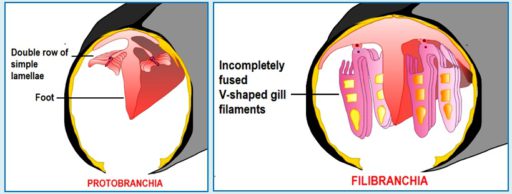
Eulamellibranchia: [Gk. eu = true, well +L. lamina = thin plate + L. branchia/Gk. brankhia = gills] i.e., gill filaments reflexed completely and fused completely to form tissue sheets on each side of the body e.g., oysters, freshwater mussels, clams, cockles etc.
Septibranchia: [L. septum = wall, fence, enclosure + L. branchia/Gk. brankhia = gills] i.e., unique in their possession of a horizontal symmetrically fenestrated muscular septum (highly modified ctenidia that lack gill filaments) e.g., Promaya.
CLASS 7: CEPHALOPODA or SIPHONOPODA
[Gk. kephale = head + pous/podos = foot or Gk. kephalopodes = head feet]
[Gk. siphon = tube + pous/podos = foot]
i.e., referring to dorso-ventrally elongated molluscs having ‘foot’ modified into ‘arms and tentacles’ on the head region (hence, head feet) and presence of a muscular tube or funnel, the hyponome, a modified part of the foot (< Gk. hyponome/hyponemesthai < hypo = below/under + nemesthai = to distribute i.e., underground passage, water pipe, conduit) below the head for the exit of respiratory water entering into the mantle cavity (hence, Siphonopoda). Nautiloids, Cuttlefish, Squids and Octopuses constitute the Cephalopod diversity.
Other Important features: Shell external or internal or absent. An extension of hind gut in the form of a muscular bag is present in the form an ‘ink sac’, containing pure melanin and expelled as an ink cloud for defensive purposes (hiding/running away in the dark cloud).
COMMON NAMES
Nautilus: [< Gk. nautilus = sailor] i.e., referring to its webbed arms used for sailing along the surface, hence the name.
Cuttlefish: [<L. cutler = knife, razor] i.e., referring to the shape of the unique internal shell (= cuttlebone).
Squid: [< sailor’s variant of ‘squirt’] i.e., referring to the ‘squirting act’ of the ‘ink’ from the ink sac.
Octopus: [< GK. okto = eight + pous/podos = foot] i.e., referring to the unique ‘eight-footed’ molluscans.
Ref.: https://en.wikipedia.org/wiki/Cephalopod
SUBCLASSES OF CEPHALOPODA
Traditionally, Class Cephalopoda is divided into 3 Subclasses:
Ø Subclass: Nautiloidea/Tetrabranchia: [< Gk. nautilus = sailor] [Gk. tetra– = four + L. branchia/Gk. brankhia = gills ] i.e., originally referring to a type of octopus of the genus Argonauta, (‘paper nautilus’), supposed to use two of its arms for sailing along the surface. All have a chambered (due to transverse and perforated septa), external, brightly ornamented and pearly, planospiral shell and 2 pairs (= four) ‘gills’ (hence, Tetrabranchia). Unlike other Cephalopods, ‘foot’ is differentiated into soft, long, flexible and retractile 60-90 tentacle or ‘cirri’.
Example:
· Nautilus:
Ø Subclass: Ammonoidea: [< L. ammonis cornua = horn of ammon] i.e., referring to extinct Cephalopods having the shell shaped like ‘coiled horn of rams’ or the Egyptian God Ammon (Amun) who is usually depicted wearing rams’ horns.
Example:
· Perisphinctes: [GK. peri = around/about + sphinktos/sphingein = tightly bound/to bind fast] i.e., referring to an extinct Ammonite from Jurassic with a quite conventional, symmetrical, serpenticona (shaped like a coiled snake, with little overlap of the turns), planospiral shell (tightly wrapped in a flat spiral).
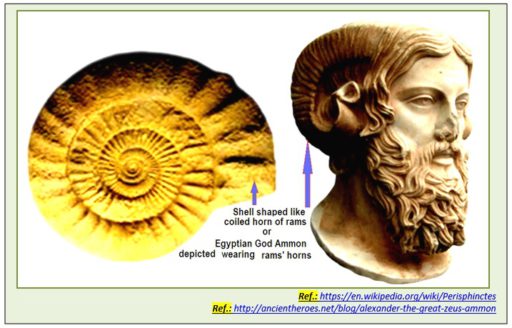
Ø Subclass: Coeloidea or Dibranchia: [< Gk. koleos = sword-sheath, scabbard + eidos = form, type, species] [< Gk. dis- = two, twice + L. branchia/Gk. brankhia = gills ] i.e., referring to such soft-bodied Molluscs, the body working as a ‘sword-sheath’ by being protecting the internal shell called a ‘cuttle bone’ or ‘pen’ or ‘gladius’ and also those possessing 1 pair of gills (= Dibranchia).
The ‘foot’ is modified into 10 or 8 arms, hence represented by two Orders viz.,
§ Order – DECAPODA: [< GK. deca = ten + pous/podos = foot] i.e., referring to those Cephalopods which have 2 long (tentacles) and 8 short arms and secreting an internal shell called, the ‘cuttle bone’ [<L. cutler = knife, razor] or an arch-shaped ‘chitinous shell’ called, the ‘pen’ or ‘gladius’ [< L. gladius = a kind of sword used by Romans].
Example:
· Sepia (Cuttlefish): [Gk. sepia = reddish brown colour] i.e., referring to a Cephalopod with an ink sac producing a rich brown pigment.
· Loligo (Squid): [L. lolignis = a squid] i.e., referring a fast-swimming ten-armed cephalopod having a long tapering body with triangular tail-fins.

§ Order – OCTOPODA: [< GK. okto = eight + pous/podos = foot] i.e., referring to those Cephalopods which have 8 equal-sized arms and are without an internal shell.
Example: Octopus:
|
Learning is an on-going process: Keep on venturing more into the fantastic world of ETYMOLOGY |
‘BIO-ETYMOLOGY’– PART – 12
Phylum: ECHINODERMATA



